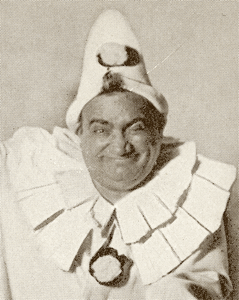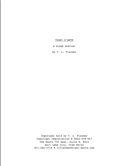Synopsis
(Note: Most scenes are accompanied by a well-known opera aria or instrumental selection. Go to Music for a complete rundown of the music and more details about the play.)
ACT I
Act I begins when the ghost of tenor Enrico Caruso (Ghost Enrico) greets the audience and introduces the ghost of soprano Frances Alda (Ghost Frances). After some comic interplay between the ghosts, and a hilarious introduction to the living Caruso, the two ghost-narrators present the main characters one by one as they arrive at a theater entrance. Geraldine Farrar, a soprano—and for a time, a movie star—whose fame equaled Caruso’s in their day, arrives wearing an immense, attention-getting hat. Dictatorial conductor Arturo Toscanini, on the other hand, reveals his disdain for publicity. Then there is feisty living version of Frances Alda, arriving with Giulio Gatti-Casazza, recently recruited to the New York opera scene from La Scala. The stormy relationship between diva Farrar and conductor Toscanini evolves first, followed by the less passionate, more comic relationship of Frances Alda and Signor Gatti. The latter relationship leads to a wedding, which Ghost Frances tries hard to impede. Act I ends when Enrico Caruso discovers that he is being sued for breaking a promise to marry. “Oh no! Not again!”
ACT II
Act II begins with the characters onboard the steamship Canopic, returning from Europe just after World War I has begun. The ominous tone is borne out as, over the course of the act, relationships fall apart. Gatti begins a lengthy affair with a ballerina, and Toscanini ends his relationship with the pretentious, but truly in love, Farrar. The act ends with Farrar singing the poignant and powerful “Un bel dì vedremo” from Madama Butterfly.
ACT III
With the beginning of Act III, we see that Farrar has rebounded, having married a movie star while making films with Cecil B. DeMille. She performs the Habañera of Bizet’s Carmen, and goes too far when she bites Caruso onstage. Alda continues in her loveless marriage, and Farrar’s husband turns out to be abusive. The two indomitable divas persevere, though, and even develop a hesitant friendship. Caruso—despite his history—meets the love of his life in his mid-forties. Sadly, he soon becomes ill. In a classically operatic death scene, he dies with his young wife at his side. Finally, the surviving characters exit the theater, mirroring the original introductions. Ghost Enrico and Ghost Frances encourage the audience members to open their minds to the music, drama, and passion of life, no matter what tribulations are faced. From Tosca, the aria “Vissi d’arte” ends the show.
 a stage cluttered with opera props, present day
a stage cluttered with opera props, present day the Monkey House at the Central Park Zoo, New York City, 1906
the Monkey House at the Central Park Zoo, New York City, 1906 a city street with a theater entrance, 1908 and 1922
a city street with a theater entrance, 1908 and 1922  a stage, backstage, and wings, representing the many opera houses in the United States and Europe where the artists performed together from 1908 to 1920
a stage, backstage, and wings, representing the many opera houses in the United States and Europe where the artists performed together from 1908 to 1920 the Hotel Knickerbocker dining room, 1912
the Hotel Knickerbocker dining room, 1912 the promenade deck of the steamship Canopic, 1914
the promenade deck of the steamship Canopic, 1914 the foyer at the Carusos’ home in East Hampton, New York, 1920
the foyer at the Carusos’ home in East Hampton, New York, 1920 the Carusos’ home in Naples, 1921
the Carusos’ home in Naples, 1921



















